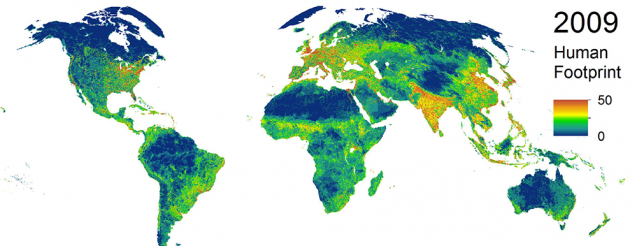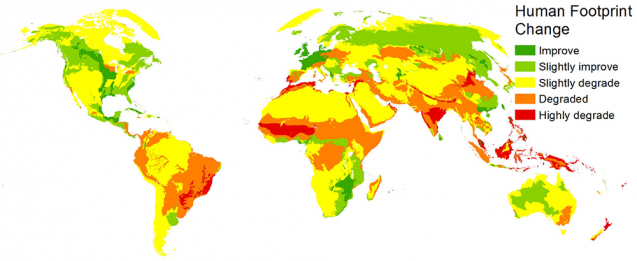Human population footprint may be growing more slowly

The human footprint continues to expand, with three quarters of earth's land surface now experiencing measurable pressures from buildings, roads, crops, pastures and other human structures and activities, according to a new report. Those pressures are building most intensely in the few remaining wild areas of high biodiversity, it notes. But the report also finds an encouraging trend: in recent years, growth in the footprint has lagged far behind population and economic growth. From 1993 to 2009, population grew 23 percent, and the global economy by 153 percent–but human influence on land went up only 9 percent. The mismatch suggests that increasing urbanization and more sustainable use of resources may be buying time for the rapidly expanding human biome, even as overall consumption of resources hits new heights. The report appears this week in the journal Nature Communications.
"The fact that the average footprint is not rising nearly as fast as our economy or population is good news," said study coauthor Marc Levy, a political scientist at Columbia University's Center for International Earth Science Information Network (CIESIN). "It gives us some basis to hope we can save some of the natural areas we have left."
The report is a followup to a landmark 2002 study that more or less coined the term "human footprint," Using data from the early 1990s, it showed the vast reach of modern civilization with a series of simple global images. Population centers in the midlatitudes and along coasts could be seen pushing up against remote regions such as the Amazon and the Arctic. It showed that a staggering 98 percent of the area where rice, wheat or maize could be grown was directly influenced by humans. Those trends have continued, the new report shows, but not nearly at the pace one might expect.
The scientists, led by Oscar Venter of the University of British Columbia and Eric Sanderson of the Wildlife Conservation Society, used advances in computing power and satellite imagery to take an updated look at eight telling measures of human influence over the land (excluding Antarctica): extent of built environments; crop land; pasture; population density; night-time lights; railways; roads; and navigable waterways. Predictably, the highest-pressure areas include western Europe, the eastern United States, China, India, and parts of Brazil and southeast Asia. Some of the biggest increases came in Southeast Asia and eastern Brazil. The remaining lands not being used by humans are largely hostile: the northern tundra and boreal forests; the Sahara, Gobi and Australian deserts; and the wet forests of the Amazon and Congo basins. (These are being gnawed around the edges as well; during the study period, some 23 million square kilometers of barely habitable lands–more than 9 percent–saw new incursions.)

On the other hand, some places saw declines in their large footprints–all within wealthy, relatively well-governed countries. Notably, almost all the nations of western and northern Europe, which have made big efforts to make their energy production and other activities more sustainable, saw declines in their footprints. Dramatic cases were admittedly in the minority: only 3 percent of the 772 ecoregions mapped by the study saw declines in human pressure greater than 20 percent, while 71 percent saw increases of 20 percent or more.
Levy lent CIESIN's expertise in large-scale data analysis and global mapping to the study. He said that in parts of South America and elsewhere, small farmers and others have been abandoning their land to move to cities. He said this has been the key to decreased, or least less slowly increasing, environmental pressures in rural areas. But he pointed out that overall population and resource use continue to grow rapidly, even if the total footprint does not mirror the numbers. That means that "business as usual is not going to get us there" in terms of long-term sustainability, he said. Instead of letting urbanization and other trends "happen by accident, maybe there are ways we can leverage them," said Levy. "There's a new interest in finding ways of encouraging things like this to happen."
More information: Oscar Venter et al. Global terrestrial Human Footprint maps for 1993 and 2009, Scientific Data (2016). DOI: 10.1038/sdata.2016.67
Journal information: Nature Communications
Provided by Earth Institute, Columbia University
This story is republished courtesy of Earth Institute, Columbia University: blogs.ei.columbia.edu/ .




















